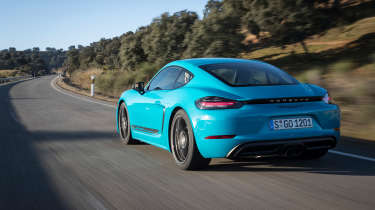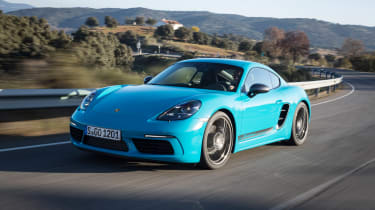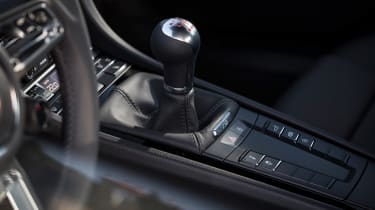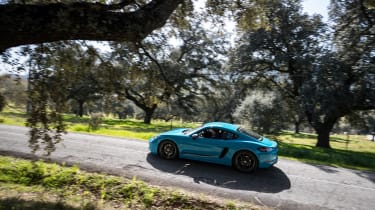Porsche 718 Cayman T review - is less more for this Alpine A110 rival?
If outright pace isn’t your priority the more focused chassis set-up of the 718 Cayman T is the pick of the Cayman range
Few cars offer such a compelling out-of-the-box package as Porsche’s 718 Cayman, but tick a few option boxes and you can turn a great car into a brilliant one. This is the path Porsche has headed down in creating its new ‘enthusiast-focused’ 718 Cayman T. Revisiting the similarly named 991 Carrera T, this latest Cayman mixes and matches a number of options to create a bespoke model positioned between the entry-level 2-litre model and the 2.5-litre S.
With a comprehensive chassis package (see below) and a handful of unique-to-the-T options (dark grey mirror caps, matching wheels and stripes make up part of the package), it could well make this newest edition the pick of the 718 range.
> Click here for our review of the Porsche 911 Carrera T
Engine, transmission and 0-60 time
The new Cayman T is based on the entry-level 718, which means its flat-four engine is the smaller 2-litre turbocharged variant. Power remains unchanged at 296bhp delivered at 6500rpm and a maximum of 280lb ft available from 2150rpm through to 4500rpm.
A six-speed manual gearbox is standard, but the shift is shorter. The dual-clutch seven-speed PDK will set you back £2303. With the former gearbox fitted, the Cayman T reaches 62mph in a claimed 5.1sec, while the launch control-equipped PDK cars knock that down to 4.7sec, with all models hitting a claimed 170mph (identical to the regular Cayman).
Technical highlights
There’s very little new or revolutionary about the T. However, that’s kind of the point. Porsche has picked the best chassis options available, a few of which are exclusive to the T, to produce a more focused model. Ride height is dropped 20mm with the fitment of a PASM sport chassis, an option that isn’t available on the 2-litre Cayman.
More reviews
There is also a more playful Sport setting for the stability management system within the Sport Chrono pack, and Porsche’s torque-vectoring and mechanical limited-slip differential and active drivetrain mounts are as standard, too, as are a pair of 20-inch Carrera S wheels.
> Click here for our review of the Alpine A110
In an effort to cut weight (or at least make the point that the T is a driver-focused car…) the Cayman’s PCM infotainment system has been removed, leaving you with a useful cubby hole in the dashboard. The PCM can be ordered as an option, something we suspect the majority of owners will do.
Aside from the fabric door pulls borrowed from the 911 GT3, it’s standard Cayman inside. You can of course go to town with more interior and trim options, with no-cost colour packs to brighten things up. The Cayman we drove was fitted with the excellent optional RS-style full bucket seats, which are lower and more supportive, but also cost an additional £3788. The optional GT sports Alcantara steering wheel and gear knob also helped to add a touch of RS to the ambience.
What’s it like to drive?
Funnily enough, it feels quite a lot like a slightly firmer, harder-edged Cayman. When you start with something as fundamentally right as the 718, that’s no bad thing. Dropping the ride height by 20mm has made an immediate difference to the ride quality, but the payoff is keener turn-in, flatter mid-corner stance and an immediacy in responding to inputs that this car was hardly lacking in the first place.
There’s more purpose to the way it flows along the road, too, and the two damper settings are – like most aspects of this car – extremely well judged. In their softer setting it’s easy to live with while remaining dynamicaly responsive, and you rarely need to use the stiffer Sport setting. When you do, though, it tightens the chassis further, while leaving enough compliance for it to remain enjoyable on most roads.
The relatively quick electric hydraulic steering does a good job of keeping you in tune with the front end, and you can make the most of the torque-vectoring and rear diff in high-speed corners as it helps to tighten your line. It’s also a bonus out of low-speed corner exits, not that the Cayman is ever struggling for traction. Understeer? Only if you have hands of ham.
Despite the higher overall limits you can still place a reassuring amount of confidence in that mid-engined chassis. The brakes are to Porsche’s usual high standards, although the optional carbon-ceramic set-up we also tried was better still, but perhaps overkill for 297bhp.
There’s no need to dwell too much on the 2-litre flat-four engine, as sadly nothing has changed. It’s still coarse and clattery at low rpm and strangely lacking in go below 2500rpm. The standard sports exhaust adds volume and a bit more noise, but struggles to hide the engine’s harshness. Although beyond 3000rpm it absolutely flies. With the turbo on song it’s got a muscular mid-range that complements the tall ratios in the six-speed manual. It’s not a patch on the old six-cylinder. Neither is it any more efficient in real world driving, despite Porsche’s claims, but for now this is Porsche’s solution to ever-tightening emission legislation.
Fight the urge to short-shift, and you’re rewarded with an engine that enjoys to be rung out to its 7000rpm peak. Perhaps surprisngly, Porsche expects Cayman T customers to opt for the manual gearbox over the PDK, with the former still one of the best manual ’boxes in terms of feel and action and despite the ratios being on the long side, therefore restricting the amount of times you can enjoy its sweet shift as a consequence.
At this point it seems only right to mention the Boxster T. Although very close to the Cayman, and identical in spec, the changes between the two in terms of driver enjoyment are thin on the gorund. In reality it does nothing to take the edge off the 718’s sharp chassis.
Price and rivals
Starting from £52,005, the Cayman T is £1741 cheaper than the more powerful and larger engined Cayman S, although to spec the chassis of the S to match the T would add close to £10,000 to the price of a Cayman S. The key to the 718 Cayman T’s success will be its keen price and unique specification, with it representing nearly £8500 worth of additional equipment for a £7000 premium over a basic Cayman.
If you’d rather go roofless, the Boxster T starts at £53,916, an £7265 premium over the regular Boxster.
As for rivals, there’s only one car, short of a Lotus Elise, on the market that can match the Cayman T for driver engagement, and that’s the excellent £50,900 Alpine A110 Légende.






